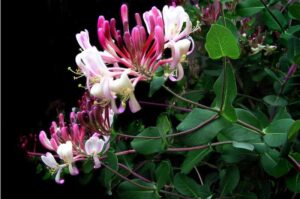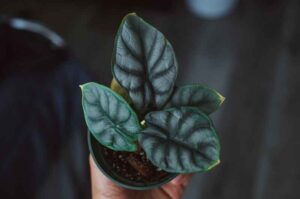Why Are My Calathea Leaves Pointing Up? (Explained)
Calatheas are quite sensitive plants, but one of their best features is that they are highly expressive. By pointing up, Calathea leaves to let you know that something is wrong. All you have to do is, identify the problem and get your Calathea to relax. Let us take a look at the causes and the solutions behind the pointing up of Calathea leaves.
Calathea leaves point up mostly due to problems like dehydration of the plant, underwatering, excessive heat, and alike. When the plant is dehydrated due to underwatering, it curls up to cut off water loss due to transpiration. However, other reasons like root rot, pests/disease, or overfertilization can also cause the situation to your Calathea.
Calathea tends to be fussy in general and can be a little difficult for a beginner. However, their habit of responding quickly to uncomfortable situations helps to identify the problems quickly. Here are some reasons due to which your Calathea might be pointing up.

Why Are My Calathea Leaves Pointing Up?
Multiple reasons can cause your Calathea leaves to point up. Take a look at all the possible reasons and their solutions to get your leaf back into its original shape.
However, the most common cause is generally due to heat. Being plants of cold and moist origin, these plants cannot tolerate direct sunlight. When the direct rays of the tropical regions fall on the plant, they curl up their leaves to save water. This is their survival instinct. By curling up the leaves, they will be able to hold on to the pores that allow transpiration.
Resolve this problem as soon as possible because in no time it can cause your plant to dry out and eventually lead to death.
Here is a list of problems, that are causing your Calathea leaves to point up, along with their solutions.
Wrong Amount Of Sunlight
The first cause why your Calathea leaves are pointing up might be because there is too much sunlight. These plants do not like to be placed under direct light.
If you live in a place where the sun’s rays are scanted, only then you should consider putting your leaves near the window, or at a place where sunlight is direct. Otherwise, you have to protect it from the direct heat of the sun.
Getting too much light curls up the leaves as they try to conserve as much water as possible. When the leaves are pointed up transpiration is less, therefore the plant is able to store more water for survival.
Getting exposed to that much sunlight will not only make the leaves curl, but eventually, they will start to dry out. If you don’t get this situation under control, the edges of your plant will start to get crispy and gradually it might even die.
Solutions:
Calathea grows under the canopies of tropical rain forests. These plants thrive best in cool, shady, low-light conditions mimicking those in the undergrowth of the rainforests.
If you want your Calathea to grow in its best form, you have to provide them with the optimum light setting. They are not tolerant to sunlight. So, you have to find a cool, shady place in your garden with high humidity and moisture. You can check this article if you want to get a better picture of a Calathea care guide.
Incorrect Watering
As discussed in the previous point, Calathea is native to a place with very high moisture. They cannot tolerate being dehydrated. As a result, underwatering is one of the most common reasons for the curling up of Calathea.
When they are not given the required amount of water, they switch to survival mode and curl up their leaves to reduce the amount of water loss. Due to this dehydration, it is a common phenomenon among the leaves to dry up and become crispy.
At the same time, too much watering is also not safe for Calatheas. It might get drowned and get root rot, fungus, or other diseases. Since Calatheas are very expressive plants, they are quick to respond to such situations.
Solutions:
If you want your Calathea to be free of any water-related issues, you have to keep a check on the soil moisture. The soil should be damp at all times but never soggy. You can use the finger method, by digging your finger in the first few inches of the soil to check if it’s wet or dry.
Unless you are trying to remove any fungal infection from the plant, never let the soil fully dry out. Also, adjust your watering schedule as per the weather. On hotter days your plant will require more water while in winters, watering the plant once a week will be more than enough. You can track the moisture level of your plant with the help of a garden moisture stick.
Too Little Humidity
Plants like Calathea thrive in high humid environments. If your area of residence has low humidity consider getting a humidifier to suit the needs of your plant.
Calathea leaves are wide and they absorb the water through the air. If all the moisture in the air dries up, your Calathea leaves will dry out, start yellowing and curl up to become pointed. Symptoms like brittle, easy to break, rough-textured leaves indicate a lack of humidity in the air.
Solutions:
Unlike most household plants, misting is a great option for Calathea. Get a spray bottle and use it to mist your plant in the lightest setting. Make sure not to splash water harshly on the leaves as they are delicate and might cause structural damage.
Misting is yet a temporary option to keep your plants moist. If you are looking for a long-term solution, a small humidifier is highly recommended.
In case you don’t want to use a humidifier, you can definitely go for a pebble bed or wet peat moss. Submerge them in a pool of water and keep them under the plant, making sure it doesn’t directly touch the root.
The water will evaporate during the day keeping the air around the plant moist while the peat moss or pebble bed will retain some moisture and maintain the humidity levels for the rest of the days.
Temperature Extremities
Calathea grows in tropical rainforests and these plants require the temperature of their native environment. If the temperature around the plant inclines on either side, it can cause the plant major distress.
If it gets too cold, the plant curls up in order to keep itself warm. If the temperature is too hot, the plant might start to dry out. To prevent as much water loss as possible, the plant enters into its survival more and points upside to reduce the loss of water.
This problem needs to be addressed by adjusting the temperature of the plant in the right manner.
The optimum temperature for a Calathea plant is between 60-85°F (16-29°C). The Calathea should not be placed directly in front of an air conditioner or heating vent. Use a thermostat to adjust the temperature of your room if the plant is repeatedly curling up.
Solutions:
If your plant is not relaxing even with the optimum temperature, increase the thermostat from the 75°F (24°C) mark. Move towards heat and keep checking the temperature until the plant relaxes.
Calatheas are very sensitive to temperature. As soon as you see your plant curling up, try out these temperature adjustments. Place your hand in front of the plant to feel the temperature of the air. It should feel moderate.
Extreme cold or hot air can send your plant into shock causing certain permanent damages. Electronics like ovens, computer desktops, air conditioners, refrigerators can affect the temperature surrounding your plant.
If you have the optimum temperature in your room yet your leaves are curling, you have to adjust the thermostat towards 75 degrees mark. Keep a check on how your plant reacts to the temperature. After a few days, if you notice any change, your problem has been resolved.
Type Of Water
Even though one might not generally consider it, but the type of water used to water your Calatheas also affects the health of the plant. If you live in a place with hard water, your plant is probably getting more harmed than helped with the watering.
As we as discussed so far, curling can occur due to a number of reasons, which might be difficult to identify immediately. Even though unlikely, this is one of the reasons why your Calathea may be pointing up. Calatheas are not very tolerant of to overabundance of minerals in the water source.
Tap water consists of high levels of salt. Using tap water regularly to water your Calatheas will cause them to fade and essentially wilt. If the plant is facing hard water troubles, the leaves will get yellow around the edges and you are also likely to see mineral build-up on the surface of the soil.
Solutions:
To deal with this problem try switching to distilled water or bottled water. Notice if there are any changes in your plant with a water change, and you will be able to identify if the problem is due to the wrong type of water.
The best option available is, depending upon where you stay, if the place has plenty of rainfall, collect rainfall and use it to water your plants. Make sure to bring the water to room temperature and water your plants right.
The tip is to not water too much at a time. Check the moisture of the soil and add only the amount needed.
These were some of the reasons that are making your Calathea Pointing up.
Final Words
So, these were some of the reasons why your Calathea leaves are pointing up. Remember to carefully notice what the plant is trying to tell you. Being a highly expressive plant, you will be aware almost immediately if it is in distress.
The causes of curling are mostly due to overheating, underwatering, or dehydration. Adjust the water, humidity, temperature, and lighting of your plant to bring their optimum levels, and you are good to have Calathea leaves that are straight, shiny, and flawless.






